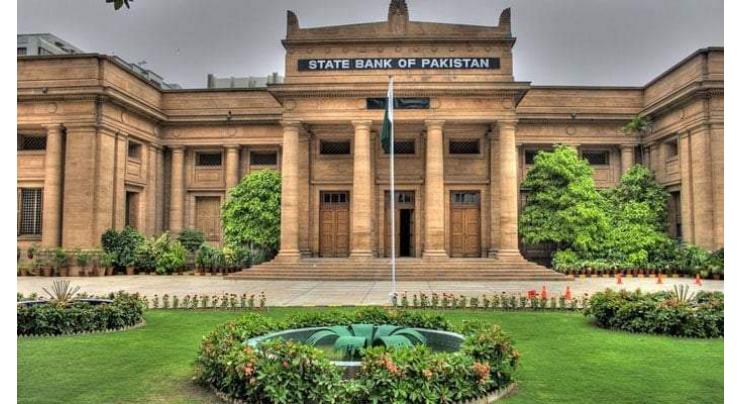
Continuing Tight Monetary Stance SBP Maintains Policy Rate At 22%
Muhammad Irfan Published April 29, 2024 | 08:20 PM

The State Bank of Pakistan, Monday, persistently kept policy rate unchanged at 22 percent while stressing on continuation of the current monetary policy stance to bring inflation down to the target range
KARACHI, (UrduPoint / Pakistan Point News - 29th Apr, 2024) The State Bank of Pakistan, Monday, persistently kept policy rate unchanged at 22 percent while stressing on continuation of the current monetary policy stance to bring inflation down to the target range.
The central bank, in a statement issued here following the meeting of the Monetary Policy Committee (MPC), noted that the macroeconomic stabilization measures though contributing to considerable improvement in both inflation and external position amid moderate economic recovery, level of inflation was still high despite of descending trends.
The committee reviewed Inflation outlook and found it in line with the MPC’s expectations as inflation has continued to moderate noticeably in H2-FY24. Headline inflation in March declined to 20.7% from 23.1% in February while core inflation fell significantly to 15.7% from 18.1% in February.
Besides the coordinated tight monetary and fiscal policy response, other factors that have led to this favorable outcome include lower global commodity prices, improved food supplies and high base effect.
The Committee viewed that inflation would continue to remain on downward trajectory, however, the inflation outlook was susceptible to risks emanating from the recent global oil price volatility along with bottoming out of other commodity prices; potential inflationary impact of resolution of circular debt in the energy sector; and tax rate-driven fiscal consolidation going forward.
Cognizant of these risks, the Committee assessed that it is prudent to continue with the current monetary policy stance at this stage, with significant positive real interest rates to bring inflation down to the target range of 5 - 7 percent by September 2025.
Global commodity prices appear to have bottomed out with resilient global growth while recent geopolitical events have also added uncertainty about their outlook, the committee observed and also taken possible impacts of upcoming budgetary measures on near-term inflation outlook in to consideration.
The MPC reviewing key developments since its last meeting noted that strong rebound in agriculture sector led the moderate recovery of economic activity in the first half of FY24 while current account recorded a sizable surplus in March 2024, which helped to stabilize the SBP’s FX reserves despite substantial debt repayments and weak financial inflows.
Inflation expectations of consumers inched up in April 2024, whereas those for businesses declined in the country while leading central banks particularly in advanced economies have adopted cautious policy stance after noticing some slowdown in the pace of disinflation in recent months, the committee further noted.
“Incoming data continues to support the MPC’s earlier expectation of a moderate recovery in current fiscal year with real GDP growth projected to remain in the range of 2 to 3 percent,” the committee observed while citing incoming data of Real Sector.
Agriculture sector remains the key driver with robust 6.8 percent growth in H1-FY24, supported by significant increase in rice, cotton, maize and wheat harvests while in the industrial sector, large-scale manufacturing reported a 0.
5 percent decline in July-February FY24 compared to 4.0 percent contraction recorded in the same period last year.
In the services sector, the Committee noted that the growth in H1 was slightly lower than expected, reflecting the impact of subdued demand. Based on relatively improved capacity utilization and business sentiments, as well as low base-effect from last year, the MPC expects value-addition from manufacturing and services sectors to recover in the coming months.
In the External Sector; the current account has turned out better than expected, recording a surplus of $619 million in March 2024, mainly owing to the Eid related surge in workers’ remittances while during three quarters of FY24 the current account deficit cumulatively narrowed by 87.5% to $0.5 billion.
The MPC reviewed that exports continue to exhibit steady growth- led by rice- while imports have decreased in the wake of better domestic agriculture output and moderate economic activity.
This reduction in the current account deficit- amidst weak financial inflows- allowed SBP to make sizable debt repayments, including that of a $1 billion Eurobond, while sustaining the SBP’s FX reserves around $8.0 billion.
The MPC emphasized that a further build-up in FX buffers is essential to enhance the country’s ability to effectively respond to external shocks and support sustainable economic growth.
The committee while reviewing the Fiscal sector found the outcome in line with fiscal consolidation efforts and observed that primary surplus increased to 1.8 percent of GDP during July-January FY24 from 1.1 percent in the same period last year.
“This improvement is mainly led by continuous increase in revenue collection and some restrain on non-interest expenditures. Sizeable increase in both tax and non-tax revenues largely reflects the impact of taxation measures and ongoing economic recovery,” the MPC said adding that the interest payments, however, have increased due to high debt levels and the government’s reliance on expensive domestic borrowing.
As a result, the overall deficit increased to 2.6% of GDP during July-January FY24 from 2.3% in the same period last year, the MPC observed and reiterated “Continuation of fiscal consolidation, particularly through broadening the tax base and reducing losses of public sector enterprises, is essential for price stability and durable economic growth.”
The MPC observed 17.1% year on year increase in broad money (M2) growth in March 2024 from 16.1 percent in February 2024 while reserve money growth increased to 10 percent from 8.2 percent. The committee attributed the M2 increase to expansion in net foreign assets on the back of improved FX reserves and increased net budgetary borrowing from commercial banks while private sector credit continues to show a broad-based deceleration.
The MPC viewed that the recent growth in monetary aggregates is expected to decelerate in the coming months, and this has already started to reflect in the latest data but underlying compositional changes in M2 will have positive impact on the inflation outlook.
Related Topics
Recent Stories

Imran Khan appears before SC via video link in NAB amendment case

IHC registrar office responds to Vawda’s letter

Currency Rate In Pakistan - Dollar, Euro, Pound, Riyal Rates On 16 May 2024

Today Gold Rate in Pakistan 16 May 2024

KP Assembly to pass caretaker govt's budget to fulfill constitutional responsibi ..

No plans for taxation on solar net metering: Power minister

Musadik urges political dialogue to resolve past conflicts

Funerals held for victims of attack on DR Congo camp

Federal govt reduces petrol price by Rs15.39 per litre

CM Bugti announces Rs 50 bln tube-wells solarization project

Vawda demands evidence about alleged interference in judiciary

Paramedical Association delegation calls on provincial president of PA Salam in ..
More Stories From Business
-
Shipping Activity at Port Qasim
27 minutes ago -
Turkish stock exchange flat at open
47 minutes ago -
Commerce minister chairs high-level Committee on export facilitation
47 minutes ago -
EXCHANGE RATES FOR CURRENCY NOTES
3 hours ago -
Foreign exchange rates
3 hours ago -

Currency Rate In Pakistan - Dollar, Euro, Pound, Riyal Rates On 16 May 2024
3 hours ago
-

Today Gold Rate in Pakistan 16 May 2024
4 hours ago -
Govt announce to decrease in petrol by Rs 15.39, HSD by Rs 7.88 per liter
13 hours ago -

Federal govt reduces petrol price by Rs15.39 per litre
13 hours ago -

Govt committed to support business community:Finance Minister
14 hours ago -

Stock markets set records, dollar slides as US inflation cools
14 hours ago -

ECC grants Rs. 23 billion for AJ&K government
15 hours ago











